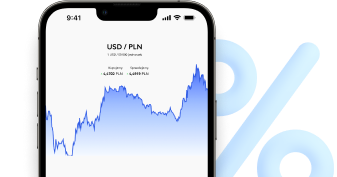Exchange rate JPY - Japanese yen
The Japanese yen is the official currency of Japan. Due to the strong position of the Japanese economy in the world, the yen is considered one of the most important currencies. One yen is equal to 100 sen.
Select currencies and check rates
Live rates.
Update: 30s
| Currency | Buy | Sell | Name | Currency code |
|---|---|---|---|---|
| JPY PLN | 2.5518 | 2.6015 | Japanese yen | 100 JPY |
Japanese yen exchange rate - chart
Last currency comments
Over 900 000 reviews
Customers rate us 4.9/5.0.*
Start saving today
Forget about unfavourable rates and hidden fees. See how much you can save. Create a free account and start converting currency online.
Open account for freeJapanese yen
The Japanese yen is the official currency of Japan. Its international symbol is JPY. Officially, the yen is divided into 100 sen and 1000 rin, although the hundredths and thousandths of the currency were withdrawn from circulation in 1954.
The JPY - where is it used?
The Japanese yen is the official legal tender only in Japan. Therefore, when travelling to this Asian country, it is worth checking the yen exchange rate. Even though the yen is officially used by only one country, the currency is one of the most relevant in the world. On the currency market in 2019, it yielded in popularity only to the U.S. dollar and the euro. The high interest in the JPY is driven, among other things, by the excellent condition of the Japanese economy.
The history of the Japanese yen
The concept of the yen as a monetary unit emerged in the late 19th century when the Japanese government was carrying out economic reforms. Among the tasks was the unification of a complicated monetary system. It was modelled on the European decimal system. The yen rate was equivalent to 1.5 grams of gold or 24.26 grams of silver. In 1882 the Bank of Japan was established, which became the only body controlling the circulation of money in Japan. After World War II, the yen lost its value. Therefore, the JPY exchange rate was closely pegged to the U.S. dollar - 360 yen represented 1 dollar. However, this system was abandoned in 1971, and the Japanese yen conversion rate began to be affected by various events, including the oil crisis in 1973. After the war, the Japanese government tried to rebuild its economy based on trade and exports. That is why the government also started to intervene when the yen exchange rate appreciated or depreciated drastically. After all, a more expensive yen also means a higher price for Japanese goods abroad, which directly hurts exports. This is why the yen exchange rate has been stable for many years.
The Japanese yen - key information
The smallest denomination used in Japan is 1 yen. However, due to its low value, in some countries, the exchange rate of yen (e.g., JPY to EUR) is given to 100 units of this currency. Coins are available in denominations of 1, 5, 10, 50, 100 and 500 yen. Each coin features Japanese flora images, including an ear of rice, a Chrysanthemum and, of course, the sakura, a cherry blossom. The coins of different denominations vary in design and size, making them easy to recognize. For instance, they are easy to identify for the visually impaired. The 5 and 50 yen denominations also have a cut-out in the centre. The banknotes are available in denominations of 1,000, 2,000, 5,000 and 10,000 yen. They depict portraits of distinguished Japanese figures, architectural landmarks, and the country's distinctive nature. In 2019, Japan's Finance Minister announced a refresh of the banknotes' design. The new edition of the Japanese yen will be effective from 2024.
JPY to EUR
While the yen exchange rate plays an important role internationally, the JPY/EUR (yen to EUR) currency pair is still very popular. It is monitored mainly by those who travel to the Land of the Cherry Blossom and those who maintain trade relations with this country. The JPY to EUR is also important for investors who place part of their assets in the Japanese currency.






























